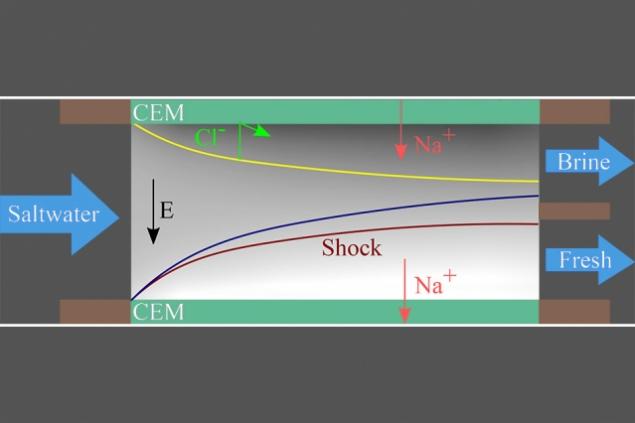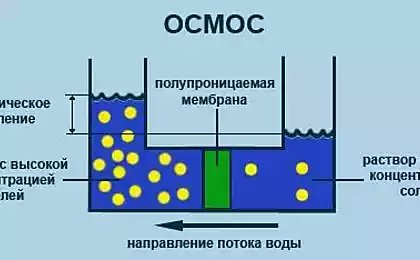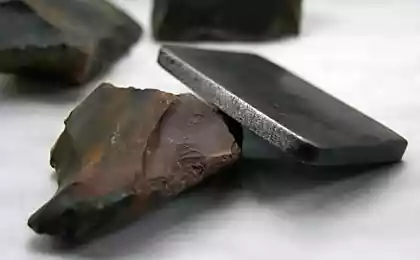910
Scientists have developed two new methods of water desalination

Almost simultaneously, the engineers at MIT (MIT) and the University of Illinois at Urbana-Champaign (UIUC) have proposed new ways to desalinate salt water. The method is based on the MIT shock waves, and UIUC used to separate salt from water porous material nanotolschiny.
If there is no water in the tap h4> The consumption of water in the world is increasing, and in some densely populated regions of the planet begins to miss her. The shortage of fresh water is no longer the prerogative of the African deserts. Despite the fact that the oceans cover 70% of the surface of our planet, drinking water it very little.
In California, for a three-year drought missed about annual precipitation , because of which the authorities had to impose restrictions on the use of water. China build one of the largest desalination stations in the Bohai Bay near the city of Tangshan.
Conventional methods of desalination is reverse osmosis - pushing water through the membrane, hindering salt particles, distillation - the boiling followed by collection and cooling of steam, or electrodialysis - change in the concentration of electrolytes in solution by means of an electric current. These methods are extremely energy-intensive.
Desalination shock h4> Work MIT engineers with необычным by desalination led by Professor Martin Bazanta [Martin Bazant] published in the journal Environmental Science and Technology. "This is a fundamentally new separation process that is different from all the others - says Bazant. - It provides diaphragmless separation of ions and water molecules ».
In conventional electrodialysis in the vessel for dividing partitions made from semipermeable membranes. Filter membranes pass water and retain larger particles salt. These membranes are arranged alternately and separated into a plurality of the total volume of the cavities. After bath solution is passed with a constant electric current, which causes the ions of dissolved salts in motion.
Oppositely charged ions move in opposite directions, but because of the fact that the tub is filled diaphragms hinder movement of ions, the ions are retained on the membrane nearest appropriate to their charge, and remain in the space between the two membranes. As a result, between one pair of membranes is an increase in the concentration of ions (the water is drained back into the sea), and between the other - a decrease that is obtained fresh water.

The new process, called shock electrodialysis, water flows through the frit - porous ceramic material. On both sides of the mass of material is limited by electrodes. Strong enough DC current flowing between the electrodes, leads to the fact that the flow of a shock wave, clearly separating the flow into two parts - one of which flows extremely salty, and the other - fresh water. One can only divide a simple flow divider.
This process does not use membranes did not clogged and requires cleaning, while providing a constant flow of water through the material is inexpensive to manufacture. The effect of the background, opened a few years ago, scientists from Stanford University.
Experts at MIT say that the process can be used not only for desalination and water purification. For example, in the course of work on the hydraulic fracturing produces a lot of salt and water contaminated with chemicals that could be cleaned in this way. Besides, according to scientists, the electric current required for the organization of the process, is strong enough to kill bacteria and sterilize the water.
Thin approach to desalination h4> The engineers from Illinois, however, offer its own version of desalination by filtering it through a membrane. However, their membrane of molybdenum disulfide has a thickness of several nanometers. Engineers from UIUC claim that their energy filter is much more beneficial than conventional filters for reverse osmosis, which require a large expenditure of energy.
For the desalination of water through the filter is usually required to create a lot of pressure, and the membranes are quickly clogged and require cleaning or replacement. But according to the engineers, the pressure required to desalinate water in proportion to the thickness of the membrane. Many scientists even tried to use graphene to filter the water, but faced with specific difficulties in its interaction with water.
Engineers from UIUC took molybdenum disulfide, molybdenum since it is surrounded by two sulfur atoms. As a result, the thin "sheet» MoS 2 sub> is outside of sulfur and molybdenum - inside. If such a sheet to make a hole, around it will ring atoms of molybdenum.

"The advantages of the filter MoS 2 sub> that attracts water molybdenum and sulfur - repellent that provides high-speed passage of water through the hole, - says Mohammed Heyranyan [Mohammad Heiranian], the author of the work. - This property is chemically incorporated into the MoS 2 sub>, so it is not necessary to specifically prepare or somehow modifying, unlike graphene, where such training is a very complex process ».
How will desalinate? h4> Progress does not stand still, and new technologies are emerging rapidly. Time will tell which of these ideas will take a reality check. It is possible that for efficiency various technologies will be used together. The main thing is that as a result they gave a lot of fresh water for drinking and for cooking - after all the main consumers of fresh water are farmers.
Source: geektimes.ru/post/265754/
Unconditional income: Finland plans to implement the first national project in the European Union
25 photos, which you definitely want to look twice

























